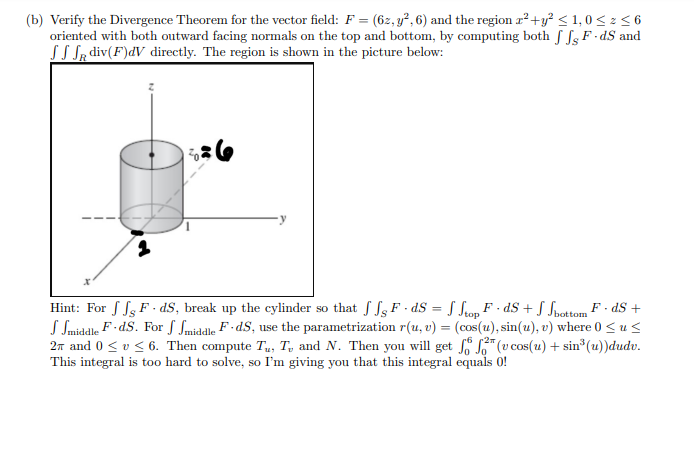(b) Verify the Divergence Theorem for the vector field: F = (6z, y², 6) and the region r? +y? < 1,0 < z<6 oriented with both outward facing normals on the top and bottom, by computing both S fgF -dS and SS S, div(F)dV directly. The region is shown in the picture below: Hint: For S Ss F · dS, break up the cylinder so that S fg F - dS = § frop F · dS + S Suottom F · dS + S Smiddle F-dS. For S Smiddle F -dS, use the parametrization r(u, v) = (cos(u), sin(u), v) where 0< u< 2m and 0 < v < 6. Then compute Tu, T, and N. Then you will get "(v cos(u) + sin (1))dudv. This integral is too hard to solve, so I'm giving you that this integral equals 0! %3D %3D
(b) Verify the Divergence Theorem for the vector field: F = (6z, y², 6) and the region r? +y? < 1,0 < z<6 oriented with both outward facing normals on the top and bottom, by computing both S fgF -dS and SS S, div(F)dV directly. The region is shown in the picture below: Hint: For S Ss F · dS, break up the cylinder so that S fg F - dS = § frop F · dS + S Suottom F · dS + S Smiddle F-dS. For S Smiddle F -dS, use the parametrization r(u, v) = (cos(u), sin(u), v) where 0< u< 2m and 0 < v < 6. Then compute Tu, T, and N. Then you will get "(v cos(u) + sin (1))dudv. This integral is too hard to solve, so I'm giving you that this integral equals 0! %3D %3D
Advanced Engineering Mathematics
10th Edition
ISBN:9780470458365
Author:Erwin Kreyszig
Publisher:Erwin Kreyszig
Chapter2: Second-order Linear Odes
Section: Chapter Questions
Problem 1RQ
Related questions
Question

Transcribed Image Text:(b) Verify the Divergence Theorem for the vector field: F = (6z, y², 6) and the region r? +y? < 1,0 < z<6
oriented with both outward facing normals on the top and bottom, by computing both S fgF -dS and
SS S, div(F)dV directly. The region is shown in the picture below:
Hint: For S Ss F · dS, break up the cylinder so that S f3 F - dS = § frop F · dS + S Suottom F · dS +
S Smiddle F-dS. For S Smiddle F -dS, use the parametrization r(u, v) = (cos(u), sin(u), v) where 0< u<
2m and 0 < v < 6. Then compute Tu, T, and N. Then you will get "(v cos(u) + sin (1))dudv.
This integral is too hard to solve, so I'm giving you that this integral equals 0!
%3D
%3D
Expert Solution
This question has been solved!
Explore an expertly crafted, step-by-step solution for a thorough understanding of key concepts.
This is a popular solution!
Trending now
This is a popular solution!
Step by step
Solved in 2 steps with 1 images

Recommended textbooks for you

Advanced Engineering Mathematics
Advanced Math
ISBN:
9780470458365
Author:
Erwin Kreyszig
Publisher:
Wiley, John & Sons, Incorporated

Numerical Methods for Engineers
Advanced Math
ISBN:
9780073397924
Author:
Steven C. Chapra Dr., Raymond P. Canale
Publisher:
McGraw-Hill Education

Introductory Mathematics for Engineering Applicat…
Advanced Math
ISBN:
9781118141809
Author:
Nathan Klingbeil
Publisher:
WILEY

Advanced Engineering Mathematics
Advanced Math
ISBN:
9780470458365
Author:
Erwin Kreyszig
Publisher:
Wiley, John & Sons, Incorporated

Numerical Methods for Engineers
Advanced Math
ISBN:
9780073397924
Author:
Steven C. Chapra Dr., Raymond P. Canale
Publisher:
McGraw-Hill Education

Introductory Mathematics for Engineering Applicat…
Advanced Math
ISBN:
9781118141809
Author:
Nathan Klingbeil
Publisher:
WILEY

Mathematics For Machine Technology
Advanced Math
ISBN:
9781337798310
Author:
Peterson, John.
Publisher:
Cengage Learning,

